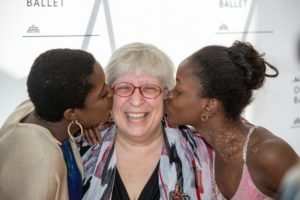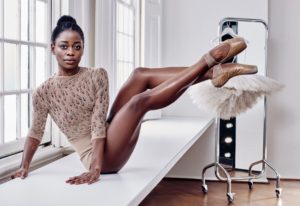Ballerina Michaela DePrince’s Remarkable Journey
Michaela DePrince is the first to tell you her life isn’t a fairy tale. But it sure might seem that way. Her story is a journey of perseverance, dedication and survival.
“The only way I could survive was… to prove everybody wrong,” she says.
She was born in 1995, originally named Mabinty Bangura. Little Mabinty came into the world in the midst of a brutal civil war in the African nation of Sierra Leone. Her father was killed by rebels. Her mother died of illness and starvation in the bed she shared with Mabinty.
“I can’t remember what my biological parents looked like,” she says. “I can’t really remember any happy moments.”
After losing her parents at age three, Mabinty was abandoned at an orphanage. And because she has a skin pigmentation condition called vitiligo, the women who ran the orphanage gave her a label—“the Devil’s Child.” They believed the white spots on her dark skin were evil or a curse.
“They kept saying, ‘Why would somebody want to adopt the Devil’s Child,” DePrince says now.
“So they ranked us, like number one was the favorite child and number 27 was the least favorite… I was number 27.” That meant she was the last child to get food at dinner, the last to receive clothing. She got rags.
She had only one friend at the orphanage — number 26, also named Mabinty. She was way down in the pecking order, simply because she was left-handed and wet the bed. The two looked out for each other and comforted each other. Mabinty number 26 would sing songs when number 27 struggled to fall asleep at night.
“She was at fault for almost everything in the orphanage,” number 26 says. “So instead of having her be timed-out by herself, we decided that we would both take the blame for it.”
It was a bleak existence. But one day, Mabinty number 27 made a discovery that would change her life. A gust of wind blew an old magazine up against the gate outside the orphanage and she found it. It was a magazine called “Dance Magazine” with a photo on the cover of a white ballerina in a pink tutu, standing on her toes. Mabinty had never seen anything like it before.
“It was not just the fact that she’s a ballerina. It’s that she looks happy. And I wanted to be happy,” DePrince says. “If what she was doing made her happy, that’s what I wanted to do… So I took the cover off and I put it in my underwear, because that was the only… safe space.”
She showed the magazine to a beloved teacher who explained that what the woman was doing was called “ballet” and she was a “ballerina.” For the first time in her life, Mabinty Bangura had something to dream about. But first she had to withstand a few nightmares.

Outside the orphanage, a group of rebels attacked that favorite teacher of hers. The teacher was pregnant. Mabinty ran out to try and intervene but she couldn’t stop the horror.
“They cut her stomach open because… they had a bet—they wanted to know if it was a girl or boy. And so they decided to find out,” DePrince says.
Then a rebel boy turned on Mabinty, slicing her stomach with a machete. She was spared only because a night watchman at the orphanage begged for her life.
“When I got stabbed, I was really hoping — I felt very much alone,” DePrince recounts through tears. “I really wanted to die. I didn’t see the point. I didn’t think I would have anything good in my life at all. I think it’s really sad that a child at three years old already wants to die…I mean, the ballerina on the front of the magazine gave me hope, but it didn’t mean that it’d be a reality at all.”
Shortly after that, she learned that Americans were coming to adopt the orphans. Her best friend—number 26—was one of the lucky ones, chosen by a family who sent a book of photos. But no one was coming for number 27.
At least, not at first.

Thousands of miles away, in New Jersey, Elaine DePrince and her husband Charles had sent that photo book to number 26. Elaine and her husband Charles had adopted before — three American boys. Tragically, they all would die of AIDS from contaminated blood. After the first two deaths, Elaine was heartbroken, but she wasn’t going to let that stop her from living and loving. One of the sons who had died had urged them to adopt from a war-torn country in Africa.
“And then i got a call from the adoption agency,” Elaine DePrince says. They asked her, “Which Mabinty are you adopting? We have two of them.”
Elaine was told that twelve families had refused to take the other Mabinty — Number 27 — because of her vitiligo. Elaine’s answer was immediate.
“I said, ‘We’ll take her.’ I said ‘I really don’t have a problem with spots, after dealing with AIDS.’”
When Elaine arrived in Africa to adopt both 4-year-olds, she was the one who broke the unexpectedly good news to Number 27.
“She was standing there with her arms folded really angry. I think… she just thought there was gonna be more rejection ahead of her,” Elaine says.
Michaela finishes the story: “Then she takes our hands and she says ‘I’m your new mama.’”
Because it would be hard to have two Mabintys, Elaine re-named both girls after her son Michael, the one who had encouraged them to adopt in Africa. Number 26 became Mia Mabinty DePrince and Number 27: Michaela Mabinty DePrince.

One of the first things Michaela did was show her new mom that treasured magazine cover.
“I couldn’t believe that I had adopted an orphan from Africa who wanted pointe shoes!” Elaine laughs. “I had to promise her…she would dance.”
Elaine kept that promise. She signed both Mia and Michaela up for ballet lessons. Michaela took it seriously from day one. Even at that young age, she was laser-focused on becoming a professional ballerina. But first, she had to get over her insecurities about the way she looked.
“I remember my first show. I was terrified because I thought, OK, well, if people could see my spots… that meant I could not become the ballerina I wanted to be.”
She asked Elaine to tell her if she could see her “spots” from the audience. Elaine reported back that she couldn’t really see the vitiligo and that it just looked like pixie dust.
Michaela’s response? “Oh good. Now I can be a professional ballerina.”
But while Michaela got more comfortable with her skin condition, she faced other obstacles because of the color of her skin. People said shocking things to her.
“When I was eight years old, this teacher said, ‘You know, we don’t put a lot of effort into the black ballerinas because they all end up getting fat and having big boobs.’” DePrince says.
Still, she persevered. And it paid off.
By 17, Michaela DePrince was performing with the Dance Theatre of Harlem in New York City. She was the youngest in the company.

The following year, she was hired by the prestigious Dutch National Ballet in Amsterdam. At 18, she was supporting herself and living out her unlikely dream. Ballet director Ted Brandsen not only hired Michaela but recently promoted her to soloist. He says Michaela’s biggest strength is her “will to succeed.”
At age 22, she’s only one level below the top-ranked ballerinas in the company. And last year, she had her brush with superstardom. Beyonce hand-picked Michaela to choreograph her own dance solo in the “Freedom” music video from “Lemonade.”
“I was like, ‘That’s Michaela! That’s Michaela!’” her sister Mia says. “She’s sitting kinda close to Beyoncé, but, you know, it’s not a big deal. It’s not a big deal right? No, it was not at all,” she says with a laugh.
Another sign of how far she’s come — Michaela is the new face of Jockey’s “Show ‘Em What’s Underneath” campaign.
Elaine DePrince says she would like Michaela’s birth mother to see how far she’s come in this world.
“She saw her child as looked down upon… This child has risen from that.”
“It’s not a fairy tale, you know. You have to work hard,” Michaela DePrince says. “There is a lot of loss, a lot of pain. But you know performing? I love it.”


